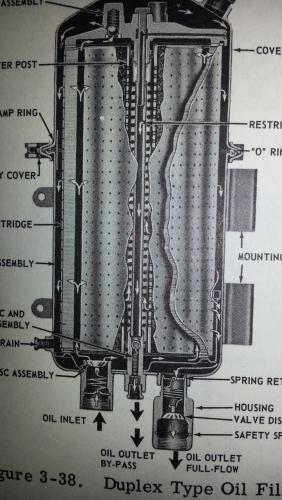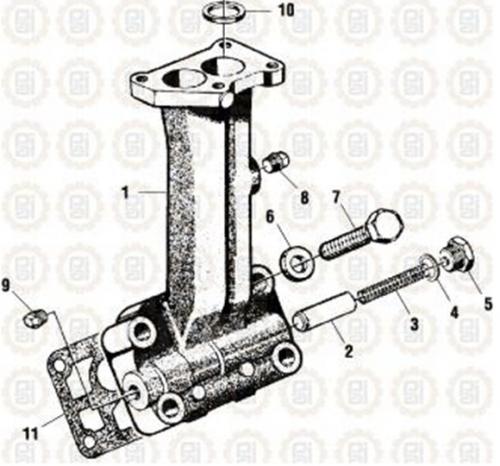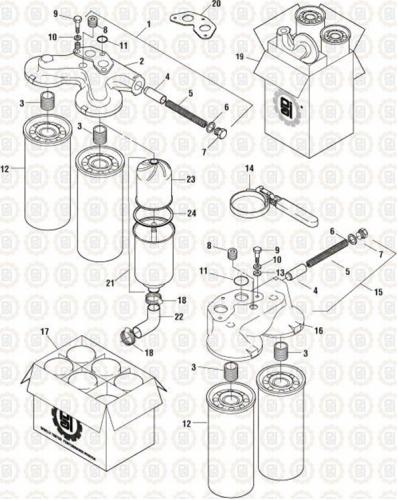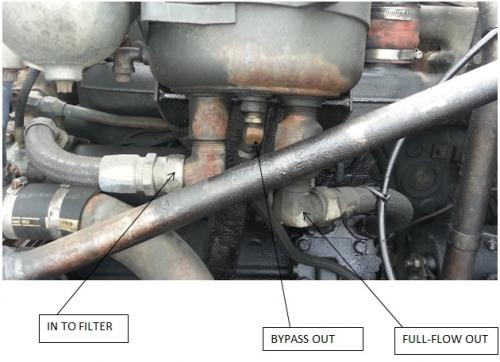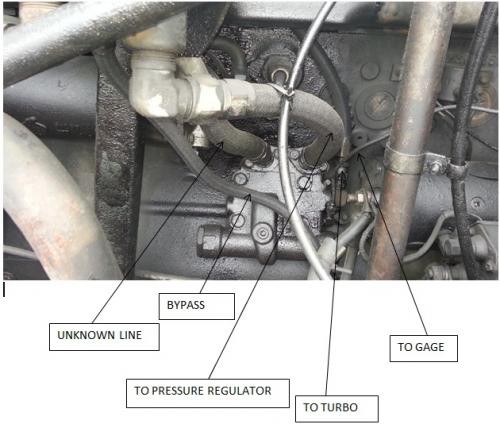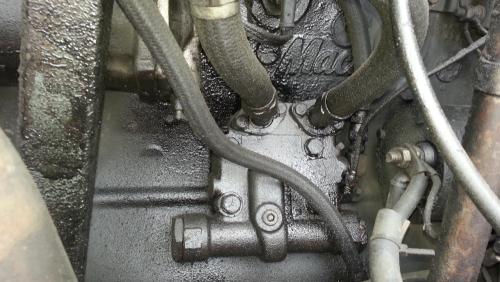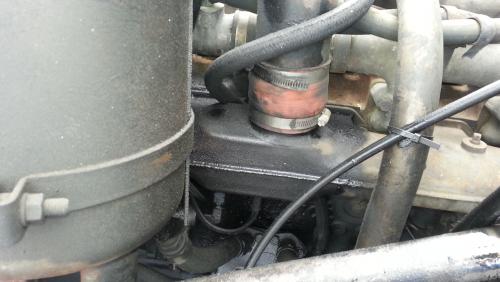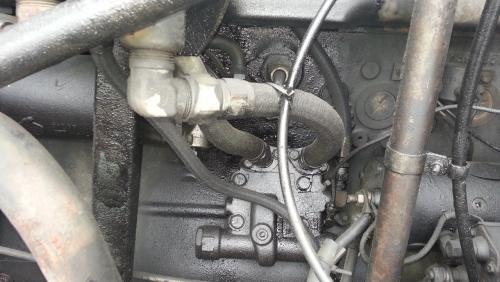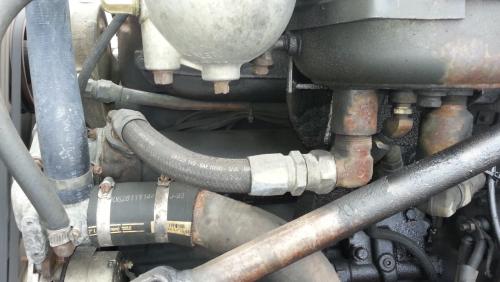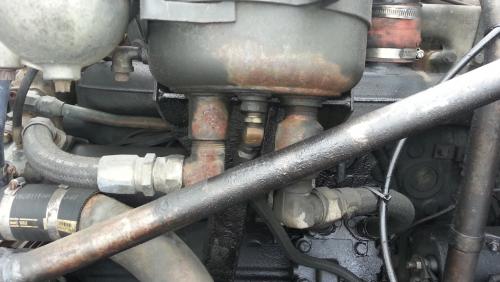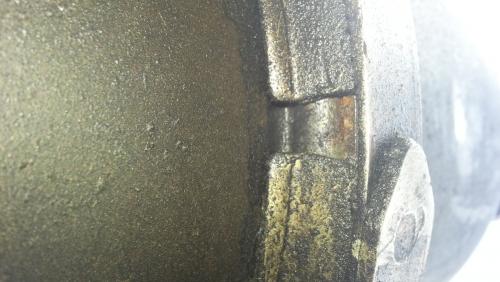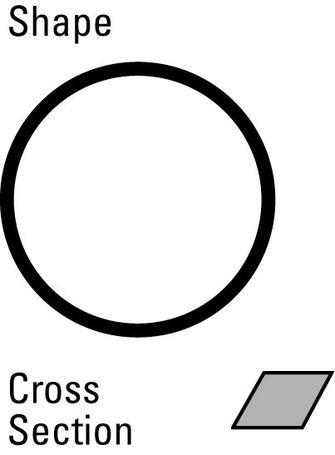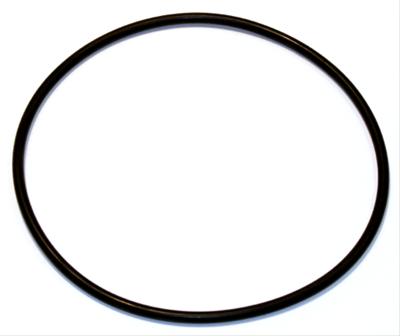-
Posts
2,618 -
Joined
-
Last visited
-
Days Won
37
Content Type
Profiles
Forums
Gallery
Events
Blogs
BMT Wiki
Collections
Store
Everything posted by doubleclutchinweasel
-
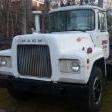
ENDT-673C LuberFiner Gasket
doubleclutchinweasel replied to doubleclutchinweasel's topic in Engine and Transmission
Yeah. That would make sense. If the oil comes out the unknown line, then passes through the cooler, it would then come out of the cooler and into the filter. Filtered oil would go out the big line, and bypass-filtered oil would go out the small line to the pan. What really drives me crazy is that none of this mess is necessary. If you look at the 3 lines coming out the bottom of the filter, they are the only things set in stone. If the supply line could connect to, let's say, a commercial dual-filter head, with an integrated bypass valve, the filtered oil could come out to the big line and the bypassed oil out to the smaller line...or even to a bypass filter. On your setup, it appears that the bypass valve is integrated into the pressure regulating valve. Bypass oil is likely dumped right back into the pan. Atually, the filters are probably a "bypass" type filter, with a built-in bypass feature. On mine, the bypass valve is integrated into the filter unit. On the pictures of the Maxi units I posted, I believe the bypass valve is integrated into the head. Seems like a great opportunity for a "generic" conversion system. Instead of changing all the coolers and manifolds, just need a unit that connects to the existing hoses. I could probably design it, but might need some help getting it manufactured. Am going to look into the Mack bypass valve parts a little more...- 44 replies
-
- luberfiner
- oil filter
-
(and 1 more)
Tagged with:
-

ENDT-673C LuberFiner Gasket
doubleclutchinweasel replied to doubleclutchinweasel's topic in Engine and Transmission
Look at this Mack drawing, noting the external check valve on the filter. Then look at my "OIL FILTER 1" picture, above. This is why I thought the in and out lines were where I marked them. Either I have them right, or the filter housing is installed backwards? Or something else...- 44 replies
-
- luberfiner
- oil filter
-
(and 1 more)
Tagged with:
-

ENDT-673C LuberFiner Gasket
doubleclutchinweasel replied to doubleclutchinweasel's topic in Engine and Transmission
From the pictures I'm seeing, the oil cooler on my Thermo is even a different part than the one on a Maxi. This may be more trouble than it's worth. Will have to wait and see if anybody comes up with any info.- 44 replies
-
- luberfiner
- oil filter
-
(and 1 more)
Tagged with:
-

ENDT-673C LuberFiner Gasket
doubleclutchinweasel replied to doubleclutchinweasel's topic in Engine and Transmission
From the looks of the PAI drawings, the 2 lines on top of my relief block MIGHT go to the top of the filter adapter? If so, they use a different manifold arrangement (3 bolts instead of 4). I wonder if the oil cooler on this 673C is the same as on the 675? If this is a different animal, too, it may get complicated. And, yes; my in and out MAY be reversed. I need to review my book tonight to see how the oil flows. Got a response from Gene at State Line. He gave me some pretty generic information, but nothing specific. I sent him some of these pictures, and asked him if they pointed him at anything specific. But, he also gave me a VIN number for a truck to use as a parts list. That might help. My biggest problem is that I simply don't have any sources around here that I know of with salvage tricks sitting around to pick parts off of. So, I have to count on others' experiences to point me at the correct parts, and THEN try to source them...either new or used. It ain't easy livin' in BFE.- 44 replies
-
- luberfiner
- oil filter
-
(and 1 more)
Tagged with:
-

ENDT-673C LuberFiner Gasket
doubleclutchinweasel replied to doubleclutchinweasel's topic in Engine and Transmission
And, here is a different pressure regulator block from the PAI website. I am assuming this is the type one would use. Also a picture of their oil filter adapter. Can't tell what would happen with that "unknown" line, above. From their pictures, it almost looks like there is one regulator piston in the block and another in the filter adapter unit.- 44 replies
-
- luberfiner
- oil filter
-
(and 1 more)
Tagged with:
-

ENDT-673C LuberFiner Gasket
doubleclutchinweasel replied to doubleclutchinweasel's topic in Engine and Transmission
Here are a couple of shots with arrows to the various lines. Maybe this will jog some memories as to what goes where, and why...- 44 replies
-
- luberfiner
- oil filter
-
(and 1 more)
Tagged with:
-

ENDT-673C LuberFiner Gasket
doubleclutchinweasel replied to doubleclutchinweasel's topic in Engine and Transmission
So, from my research so far, it LOOKS like you remove the existing oil pressure relief valve assembly, and bolt on the different one with the tall "neck" on it. Then, the filter adapter bolts to the top of that "neck". After that, it's just a matter of connecting things. So, looks like it would be very important to have the correct pressure relief assembly, to line up with the correct number of holes in the block. Right gasket would probably help, too. Looking at my pictures, I can see where part of the lines go. But, it's raining outside right now, and I don't want to get wet looking around. I assume the line coming off the oil cooler is the supply to the filter. The other large line off the filter goes into the pressure regulator. The small center line off the filter appears to be the bypass return line, and goes into the block (or pan), and drains straight into the pan. i think I can see the turbo feed line coming off the RH side of the regulator block. And, the oil pressure gage line appears to be right next to it. There is another larger line, on the LH side of the pressure regulator block. In the pictures, I can't see exactly where that line goes. I think it would be inportant to know, however, since that is one of the lines which appears to go bye-bye when you put the different regulator body on there. I'll doctor those pictures, and see if anybody can give me more info.- 44 replies
-
- luberfiner
- oil filter
-
(and 1 more)
Tagged with:
-

ENDT-673C LuberFiner Gasket
doubleclutchinweasel replied to doubleclutchinweasel's topic in Engine and Transmission
Larry, I think I found your project all over the web! Looks like you searched every diesel form out there. Sounds familiar. Yeah, mine has a block heater in that area, as well. It just might have to go. Sounds like, from your description, you eliminated the bypass portion of the original filter? That is, I believe, what the smaller, center line is for. Right? Filtered bypass oil that is dumped back into the pan? Here are a few pictures of the side of my engine, just to see if it helps anybody's memory...- 44 replies
-
- luberfiner
- oil filter
-
(and 1 more)
Tagged with:
-

ENDT-673C LuberFiner Gasket
doubleclutchinweasel replied to doubleclutchinweasel's topic in Engine and Transmission
I sent Global a message. Will contact State Line, also. Thanks, all.- 44 replies
-
- luberfiner
- oil filter
-
(and 1 more)
Tagged with:
-

ENDT-673C LuberFiner Gasket
doubleclutchinweasel replied to doubleclutchinweasel's topic in Engine and Transmission
Oh! Then that PM won't do much good, will it?!- 44 replies
-
- luberfiner
- oil filter
-
(and 1 more)
Tagged with:
-

ENDT-673C LuberFiner Gasket
doubleclutchinweasel replied to doubleclutchinweasel's topic in Engine and Transmission
I sent a PM to counterman6, who I believe is that same guy. Told him what I was looking at. I guess we'll see. If there is a "kit", and all I need to do is have hoses made, or something like that, I might be able to convince myself to do it. Otherwise...- 44 replies
-
- luberfiner
- oil filter
-
(and 1 more)
Tagged with:
-

ENDT-673C LuberFiner Gasket
doubleclutchinweasel replied to doubleclutchinweasel's topic in Engine and Transmission
Counterman6? At gloaltrucktraders?- 44 replies
-
- luberfiner
- oil filter
-
(and 1 more)
Tagged with:
-

ENDT-673C LuberFiner Gasket
doubleclutchinweasel replied to doubleclutchinweasel's topic in Engine and Transmission
Okay. So, what is a 215SB123 oil filter conversion kit? That can't possibly be all there is to it? Can it?- 44 replies
-
- luberfiner
- oil filter
-
(and 1 more)
Tagged with:
-

ENDT-673C LuberFiner Gasket
doubleclutchinweasel replied to doubleclutchinweasel's topic in Engine and Transmission
%^$#$%^^&$#!!! I just checked the oil filter canister. I appears that, after a time, the oil is draining out of the filter canister. Can't tell if it is some of the oil or all of the oil. This surprises me, because the oil pressure is not terribly slow to build up on this engine. So, "full" on the dipstick is NOT full, apparently. I guess you would have to check the oil level immediately after shutdown, while there was still oil in the filter, to see if the crankcase was actually full. And, when the filter drained, it would be way over-full. I have tried checking it at idle, but the dipstick has oil all over it then. I doubt it would be possible to get parts for these old canisters (check valves, springs, etc...). I'm sure that's what it needs; the check valves rebuilt. So, I may have to try to convert it over to spin-on filters, after all. Really did not want to do that. This may be the one that puts me over the top. I am about tired of doing this.- 44 replies
-
- luberfiner
- oil filter
-
(and 1 more)
Tagged with:
-

ENDT-673C LuberFiner Gasket
doubleclutchinweasel replied to doubleclutchinweasel's topic in Engine and Transmission
Curiosity has set in! Didn't you actually convert yours over to spin-ons? After doing a lot of reading, and being very confused, it sounds like the "3-line" units (full-flow and bypass) were a bit easier to convert to spin-on than the ones which were only bypass or only full flow. Can you shed any light???- 44 replies
-
- luberfiner
- oil filter
-
(and 1 more)
Tagged with:
-

ENDT-673C LuberFiner Gasket
doubleclutchinweasel replied to doubleclutchinweasel's topic in Engine and Transmission
WGB, huh? Cool! Never knew that. All those numbers match up with the ones I have. So that's good. This is a hobby truck, and will likely stay with the factory filter.- 44 replies
-
- luberfiner
- oil filter
-
(and 1 more)
Tagged with:
-

ENDT-673C LuberFiner Gasket
doubleclutchinweasel replied to doubleclutchinweasel's topic in Engine and Transmission
Yeah. That's me, too. The local guy said he could get me one of each tomorrow. Said to use whichever one I need & return the other. Can't beat that. Looking between the gaps, at the shape of the bottom of the canister lip, it looks like it would use a round seal.- 44 replies
-
- luberfiner
- oil filter
-
(and 1 more)
Tagged with:
-

dash plaque
doubleclutchinweasel replied to BOB DINGSDALE's topic in Exterior, Cab, Accessories and Detailing
Picture? Link? -

ENDT-673C LuberFiner Gasket
doubleclutchinweasel replied to doubleclutchinweasel's topic in Engine and Transmission
Was yours the full-flow/bypass combo, or just a single-purpose?- 44 replies
-
- luberfiner
- oil filter
-
(and 1 more)
Tagged with:
-
So, I was looking at oil filters and such for the old Dog. The ENDT-673C has the LuberFiner canister (combination full-flow & bypass) on it. Filter element number 236GB311A, I do believe. At least that's one of the numbers on the build sheet. That number crosses over to several still-available filters (Wix, Baldwin, etc...). So, no problem there. And, the dimensions & pictures I find are very familiar to me. I have handled this type before, but it has been YEARS ago. But, I have found 2 different housing gaskets (see pictures), and wonder if anybody can shed any light on it, without me having to take mine apart first. Might be a 121SB45. The first gasket I have found, which might work in there, appears to be an O-ring...round cross-section. This is what Wix calls for for their element. The other gasket I have found is a "beveled" cross-section. Personally, I would have called this a "diamond" cross-section. Both these numbers come up on one cross-reference or another. Some of these cross-references would tend to suggest interchangeability between the 2 parts. But, when you look at the dimensions, the "diamond" one is quite a bit thicker. Without taking the canister apart, I wonder if there is any way to tell what the gasket is supposed to look like. I just can't remember what the seal looked like all those years ago. And, maybe there are 2 different types of canisters. I just don't know. I suppose the "safe" way would be to have one of each on hand, and use whichever one looks right. But, that's guesswork; I hate guesswork!
- 44 replies
-
- luberfiner
- oil filter
-
(and 1 more)
Tagged with:
-

Wobble Located
doubleclutchinweasel replied to doubleclutchinweasel's topic in Driveline and Suspension
It's a hobby truck. Gets maybe 1,000 miles a year.I bought 16 Dayton rims with Bandag recaps on them for $25 each. I'll be glad to swap it over to Budds, as soon as somebody wants to donate the hubs, drums, & wheels! Until then, y'all will just have to tolerate my Daytons on Mack "spiders"! -

Wobble Located
doubleclutchinweasel replied to doubleclutchinweasel's topic in Driveline and Suspension
Pulled it off. The band was good. Replaced the outer, suspect tire with another one. Went together easy. Runout good on both inner & outer. Drove it. That particular shimmy & shake is gone. So, that funny-looking tire apparently was the culprit. Therefore, no, a set of Budds wouldn't have helped in the slightest! -

Need vin 1993 ch613 e6 350
doubleclutchinweasel replied to eveready's topic in Engine and Transmission
Serial/model number off the engine, maybe? -

Diesel Fuel Lubricity Study
doubleclutchinweasel replied to doubleclutchinweasel's topic in BMT Wiki Support Topics
Good point. As soon as I dumped a little Opti-Lube in mine, it ran smoother & idled better. I'm attributing that more to cleaning than anything. -

Diesel Fuel Lubricity Study
doubleclutchinweasel replied to doubleclutchinweasel's topic in BMT Wiki Support Topics
Yeah, I think the biggest issue is in higher-fuel-pressure engines made between 2000 and 2008. The reduction in sulphur in 2008 reduced the lubricity of the fuel, which could hurt those pumps. I do have to disagree on 1 little issue, however. According to this study, SOME of the additives actually REDUCE the lubricity. That means they INCREASE the wear on the pump. So, in those particular cases, NOTHING is better then SOMETHING...at least when discussing lubricity. To be honest, I had actually used the 2-cycle oil additive before, because the study showed it actually did help a little! But, you know that stuff probably didn't clean anything! And, remember, this article is solely discussing the LUBRICTY benefits of various additives. Even some of the additives which made no difference in lubricity probably helped cetane rating, cleaned injector nozzles, and stuff like that. It's always good to hear from you, Farmer!
BigMackTrucks.com
BigMackTrucks.com is a support forum for antique, classic and modern Mack Trucks! The forum is owned and maintained by Watt's Truck Center, Inc. an independent, full service Mack dealer. The forums are not affiliated with Mack Trucks, Inc.
Our Vendors and Advertisers
Thank you for your support!



